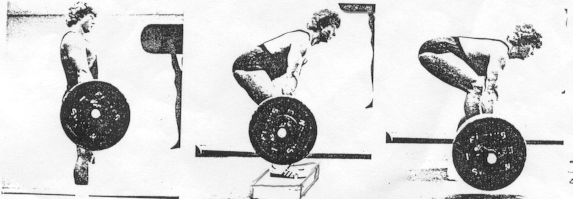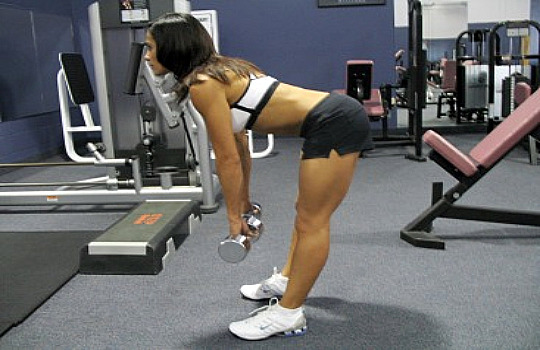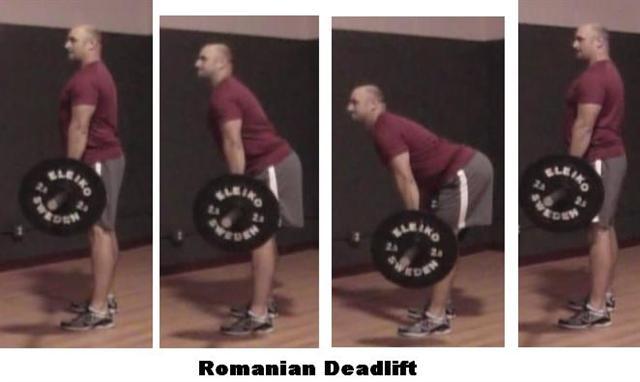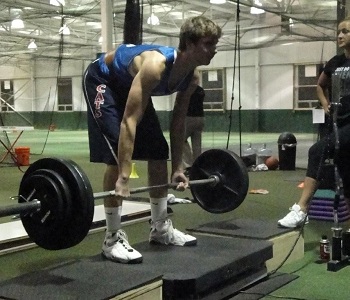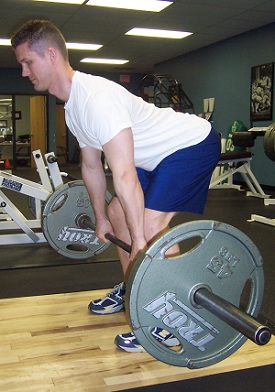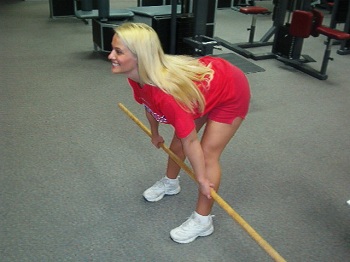Happy PR Friday. Post PRs or updates to comments
The Romanian Deadlift (RDL) is a quality exercise that can be used to strengthen the lumbar erectors, gluteals, and hamstrings — but primarily the hamstrings. The lift was introduced to the U.S. when Romanian weightlifter Nicu Vlad (coached by Dragomir Cioroslan) was doing them while training the OTC. Vlad has the heaviest double body weight snatch ever; he snatched 200kg while weighing 100kg. In any case, the RDL was adopted by weightlifters, strength trainees, bodybuilders, etc.
The RDL is often butchered by many lifters and trainees. The point of this exercise is to stretch the hamstrings, incorporate a slight stretch reflex out of the bottom, and extend the hips primarily with the hamstrings. The most often error is flexing (bending) the knees too much. Flexing the knees closes the knee angle and contracts the hamstrings a little bit. If the hamstrings are contracted slightly, then they can’t be stretched out appropriately for the efficacy of the lift. In movements like the RDL and Good Morning, the purpose isn’t to load weight on the bar and measure your dick. Instead, they should be done correctly as to work the muscle.
How To Do It
Assume a hip-width deadlift stance. Some inexperienced trainees deadlift with wider stances and aren’t going to properly train their structures. It may be that their structures haven’t been developed to do it correctly, so they use a wider stance because it allows them to lift more weight. This is like taking vitamin C to treat a cold; it merely treats the symptoms. The RDL can help develop musculature for the deadlift.
The grip will be right outside of the legs and hips — not narrow enough so that the knuckles of the thumb drag on the thighs, but not much wider. The RDL stops in the “hang position”, or the same position of a locked-out deadlift. From this standing position, the knees are merely UN-LOCKED as the hips are pushed back. It’s imperative that the knees don’t flex more than this UN-LOCKED position since knee flexion will reduce the stretch on the hamstrings. More weight can be lifted when the knees are flexed more, but that doesn’t make it right. Just because you can doesn’t mean you should.
Pus the hips back with UN-LOCKED knees. The upper and lower back will remain in extension (but not hyper-extension — females take note) while the hips are pushed back. The lifter can imagine pushing their butt back towards the wall behind them. The knees should NOT travel forward at all. If the knees have traveled forward, then they have flexed. Keeping the shins vertical accounts for not allowing them to travel forward.
The next important point is to keep the bar back into the legs. If the bar flops forward, then it throws off the mid-foot balance, ruins the efficacy of the lift, and the extensors of the shoulders don’t get any work.
Now look at the picture of Vlad doing them above. Notice how he has some extra knee flexion? Don’t do this. He appears to be aiming for a greater stretch in his hamstrings and is even standing on a block to do it. Instead, emulate the following picture.
The only thing wrong with this guy is that the third picture isn’t the bottom of the RDL. The angle of the back will be right at, or possibly above parallel. The weight will NOT touch the floor; it will reduce the tension on the hamstrings as well as the stretch reflex. However, that guy is doing a good job of un-locking his knees and not letting them go forward while he pushes his hips back to lower the weight. Another way to think of it is that the knees are slightly flexed but don’t flex anymore while the hip flexes.
Points of Emphasis
1. Start in the hang
2. Un-lock knees
3. Push hips back
4. Don’t let knees go forward
5. Keep the bar back
6. Once the back angle is arbitrarily parallel, or the hamstrings are sufficiently stretched (you’ll know), reverse the movement
7. Drive the heels through the ground
8. Continue to keep the bar back and not let the knees go forward
9. Return to the hang position
Let’s look at some common faults.
1. This picture is what most people look like while doing RDLs, and it’s dead wrong. It looks like this dude has 295 lbs. on the bar when he may not be able to do 185 correctly. There is no lumbar extension, his hips haven’t been pushed back, the bar has gotten away from him, and he’s using an alternated grip. The RDL is an assistance exercise and should be trained with symmetry. If you can’t hang onto the weight throughout the course of the set, then use straps with a double overhand grip. This is all kinds of wrong.
2. This guys isn’t terrible, but he has allowed his knees to flex too much. Now he has just turned it into some kind of light weight deadlift. If you think about it as merely UN-LOCKING the knees, then you aren’t incorrectly allowing them to flex any more. Knees back, hips back.
3. This girl has done a good job of not letting the knees flex and pushing the hips back, yet she has a rounded lumbar/sacral junction. It is very possible that she has an overly long sacrum and short back, but that would require her not going as low since she has broken away from a straight torso. Make sure that the thoracic/lumbar and lumbar/sacral junctions are straight — and not hyperextended or flexed — during lifting. Another noteworthy point with this girl is that she’s looking up. Her cervical spine is extended, and having the cervical spine anything other than neutral during lifting is not preferable. Most people won’t get hurt, yet keeping a neutral spine during lifting is preferable than awkwardly extending it up (and I would say the same thing for squatting).
I’ve been meaning to take some pictures and video of the RDL, but hopefully by looking at some random internet pictures you can get an idea of what constitutes a good and bad RDL.
The Important Cues
1. Un-lock the knees
2. But don’t let them go forward
3. Push hips BACK
When To Do Them
RDLs are a great assistance exercise for deadlifts and can even be used in lieu of deadlifts in older trainees, very weak trainees, or females. It’s no great secret that a lot of figure competitors use RDLs to build wonderful backsides, so the prospect of incorporating them with squats may appeal to the gal who is weary of lifting in general.
I like having high-bar squatters RDL on a regular basis. The high/low bar bickering may be boring or entertaining, yet the two movements develop hip musculature differently. By adding in RDL’s in a high-bar program, they can help develop the strength and musculature of the hamstrings.
For a regular strength trainee, I would have them do the RDL’s in the opposite end of the week from deadlifts. If you deadlift on Fridays in a LP or TM set up, then do RDL’s on Monday or Tuesday (the Assistance Day for the TM). If you are running the Greyskull LP, then you could do them on Friday.
If the RDL is used correctly, it can help out a lot. I suggest starting with 135 for 8 to 10 reps. Assuming you haven’t been doing them, you’ll probably be sore. Increase the weight each workout and decrease the reps until you’re doing it for 3×5 and progressing it like a strength lift. Take your time getting to 225 lbs for three sets of five. That’s normally where my work sets are and I’ve done it with 110kg before. If you’re getting beyond 275 and you don’t weigh over 230, then you’re probably doing them wrong. I’ve seen various sub 200 pound friends doing them with around 300, and they weren’t getting the full benefit. Gutting through RDLs with a round back and knee flexion isn’t doing RDL’s, it’s doing shitty deadlifts. Use this to train the lumbar extensors to maintain their position while the hamstrings eccentrically and concentrically work. It’s what is supposed to be happening in a deadlift anyway, and unless you’re a powerlifter it’s how deadlifts should primarily be done anyway.

